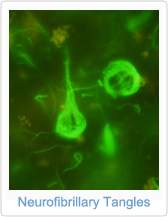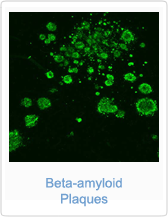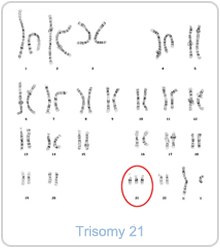What causes Down Syndrome?
In every cell in the human body there is a nucleus, where genetic material is stored in genes. Genes carry the codes responsible for all of our inherited traits and are grouped along rod-like structures called chromosomes. Normally, the nucleus of each cell contains 23 pairs of chromosomes, half of which are inherited from each parent.
Down syndrome is usually caused by an error in cell division called "nondisjunction." Nondisjunction results in an embryo with three copies of chromosome 21 instead of the usual two. Prior to or at conception, a pair of 21st chromosomes in either the sperm or the egg fails to separate. As the embryo develops, the extra chromosome is replicated in every cell of the body. This type of Down syndrome, which accounts for 95% of cases, is called Trisomy 21.
The two other types of Down syndrome are called mosaicism and translocation. Mosaicism occurs when nondisjunction of chromosome 21 takes place in one-but not all-of the initial cell divisions after fertilization. When this occurs, there is a mixture of two types of cells, some containing the usual 46 chromosomes and others containing 47. Those cells with 47 chromosomes contain an extra chromosome 21. Mosaicism accounts for about 1% of all cases of Down syndrome. Research has indicated that individuals with mosaic Down syndrome may have fewer characteristics of Down syndrome than those with other types of Down syndrome. However, broad generalizations are not possible due to the wide range of abilities people with Down syndrome possess.
What is Alzheimer’s disease?
Alzheimer’s disease is the most common form of dementia in the elderly (accounting for 60-80% of patients) and in people with Down syndrome. Currently, in the United States over 5.3 million people have the disease. Alzheimer’s disease is a dementia that includes the loss of memory and other thinking skills. People diagnosed with dementia usually show:
- Progressive loss of the ability to generate coherent speech or understand written or spoken language.
- Difficulties recognizing or identifying objects (even with corrected vision).
- Decline in ability to do motor activities (even if one understands what needs to be done).
- Problems thinking abstractly, making sound judgments, planning and carrying out complex tasks.
- Importantly – these changes in thinking must be severe enough to interfere with daily life.
There are several warning signs of Alzheimer’s disease but it is important to remember that change in function is the most important indicator:
- Memory loss that disrupts daily life.
- Problems solving problems or in planning.
- Difficulty completing familiar tasks at home, at work or at leisure.
- Confusion with time or place.
- New problems with words in speaking or writing.
- Losing or misplacing things.
- Withdrawal from work or social activities.
- Changes in mood or personality.
What are the brain changes that happen with Alzheimer’s disease?

Several changes must occur in the brain for a final diagnosis of Alzheimer’s disease. Two types of neuropathology are thought to cause dementia in this disease including neurofibrillary tangles and beta-amyloid plaques.
Neurofibrillary Tangles
Inside the brain are nerve cells (neurons). Inside of neurons there is a normal protein called tau that is important for proper functioning. In Alzheimer’s disease, tau becomes abnormal (hyperphosphorylated) and this leads to a twisting up of long filaments (strings) that fill up the neuron and prevent it from functioning properly. Eventually, neurons die from these changes leading to many disconnections between neurons and between different parts of the brain. When this happens, the clinical signs of dementia can be seen.

Beta-amyloid Plaques
Plaques form in between neurons in the brain as big clumps of a protein called beta-amyloid. This beta-amyloid protein is very toxic to neurons and in high enough concentrations can change how they work and also lead to their death. The beta-amyloid protein is cut out of a longer protein called beta-amyloid precursor protein.
Why are people with Down syndrome more vulnerable to Alzheimer’s disease?
The gene for the beta-amyloid precursor protein that is cut to make beta-amyloid protein is on chromosome 21, which is present in triplicate in most people with Down syndrome. This means that people with Down syndrome are making more of the precursor protein than people without Down syndrome and leads them to being more vulnerable to the development of Alzheimer’s disease. Also, the age of onset of Alzheimer’s disease in adults with Down syndrome is earlier than those without Down’s and can start as young as in the 40’s. As they get older, the risk of getting Alzheimer’s disease gets higher.

Not all adults with Down’s syndrome develop dementia
Importantly, not all older adults with Down syndrome develop dementia despite making too much beta-amyloid protein. This means that some people may tolerate or compensate for these changes in the brain. This also means they can still function well on a day to day basis without the clinical signs of dementia. If, through research, we can learn how this happens, then it may be possible to develop ways to prevent or treat Alzheimer’s disease in people with Down syndrome. This is one of the long term goals of our longitudinal aging study – to discover new approaches to prevent Alzheimer’s disease in Down syndrome as people get older.
